|
The Town Green has been the focal point
of life in Longmeadow for a long time.
This summary looks at the changing
landscape of the Town Green from the
late 1700's to the early 20th century.
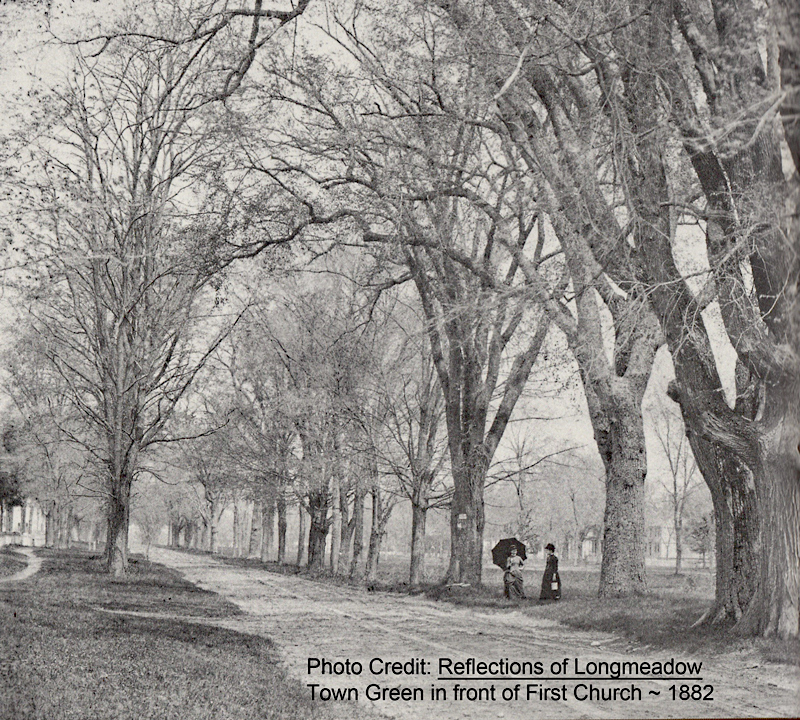
Proceedings at the Centennial
Celebration of the Incorporation of the
Town of Longmeadow (aka "The
Centennial Book") was published in 1884
for the 100th anniversary celebration of
the incorporation of Longmeadow in
1883. It contains a wealth of
information about the first hundred
years including the history of the
Green. In addition, a review of the
historic Longmeadow maps (1831, 1855,
1870, 1894, 1910 and 1920) of the Green
provides some great insight as to its
history.
Here are highlights
of the early history of the Green
through the early 20th century....
-
Prior to 1831
there were numerous shops on the
Green as well as a School
House and the
Meeting House. These shops
were granted 40 year leases on the
Green with the last lease starting
in 1795.
-
The 1831 map
shows only the School House
and the Meeting
House (--> Congregational
Church) remaining on the Green.
There were no shops in 1831 since
most of the leases had expired and
town leaders decided to remove them
from the Green.
-
The 1870
map shows only the
Congregational Church and the weigh
scale(?) for the Colton Store. The
School House located on the Green
was destroyed by fire in 1852.
-
Two shops (marked
sheds on the 1870 map)- the
blacksmith and the
wheelwright had been
granted leases for a section of land
west of the Olde Burying Yard but
these shops were not removed when
the leases expired. The owners
eventually achieved legal ownership
(squatter's rights?) and the Parish
was required to purchase the
properties when the Congregational
Church was moved from the Green to
its current location.
In 1874
the Congregational Church
was moved to its current
location and at that time there were
no visible structures on the Green.
In 1895-
the Springfield Street
Railway was granted a
"franchise" to operate a trolley
service from Springfield, MA to
Enfield, CT along Longmeadow
Street. It is interesting to note
that the original proposal on the
1894 map showed the
trolley tracks + electric power
poles/ lines avoiding intrusion onto
the Green. However the 1910
map shows the actual
north/south trolley path being
placed directly on the Green. For 40
years (1895 - 1940)
trolleys transversed the Green
carrying Longmeadow residents and
others to their destinations.
Here are some additional details....
The Centennial Book published in 1884
provides a great snapshot of the Green
in the early days following the American
Revolution. Here are a few excerpts...
"THE BROAD AND BEAUTIFUL LONGMEADOW
STREET has been at different times the
subject of many votes, showing how
narrow has been its escape from the most
serious encroachments, urged in the
interest of individuals, or even of the
public itself. It may surprise some to
learn that the present central section
of park-like sward was originally a long
sand-drift, -similar to many now found
in the wood-belt eastward, and that this
was reclaimed and converted into its
present verdure by a process of
enrichment and cultivation extending
over several years, carried on by a
citizen (Capt. Calvin Burt), who was
permitted for that purpose temporarily
to enclose a long section of the street.
The northern half of this same central
section was also by town permission
occupied for many years by a central
series of shops, stores, and
manufactories, under forty year leases,
in the same way that the front portion
of the Burying-Ground grant was
permitted to be occupied by a
blacksmith's and a wheelwright's shops."
"These last [blacksmith and
wheelwright shops], unfortunately, by
unchallenged occupancy for more than
forty years, gained finally a title to
the land itself which it cost the Parish
several hundred dollars to extinguish
when this corner was desired as a site
for the remodeled Church edifice in
1874. Fortunately the danger was
earlier discovered in regard to the Main
Street [Longmeadow Street] leases, and
the removal of all those buildings was
secured at the expiration of the
lease-term- while a sentiment of jealous
and loving care now exists which would
make their renewal forever impossible."
The Town stopped granting 40 year leases
to build shops in the street (Town
Green) in 1795. By 1831- because of
expired and unrenewed leases, there were
no shops remaining on the Green- only
the School House and the Meeting House
(see Figure 1 below). The School House
burned down in 1852.
The 1870 map in Figure 2 shows the sheds
which are the blacksmith and wheelwright
shops referred to in the above passage.
Because the blacksmith and wheelwright
shops (west of the Olde Burying Yard)
had been in place for greater than 40
years, the renters became owners
(squatter's rights ?) and the Parish was
required to purchase the land when the
Congregational Church was moved from the
Green to its current location in 1874.
By 1870 the only remaining structure on
the Green was the Congregational Church
which was moved to its current location
in 1874 (see Figure 2).
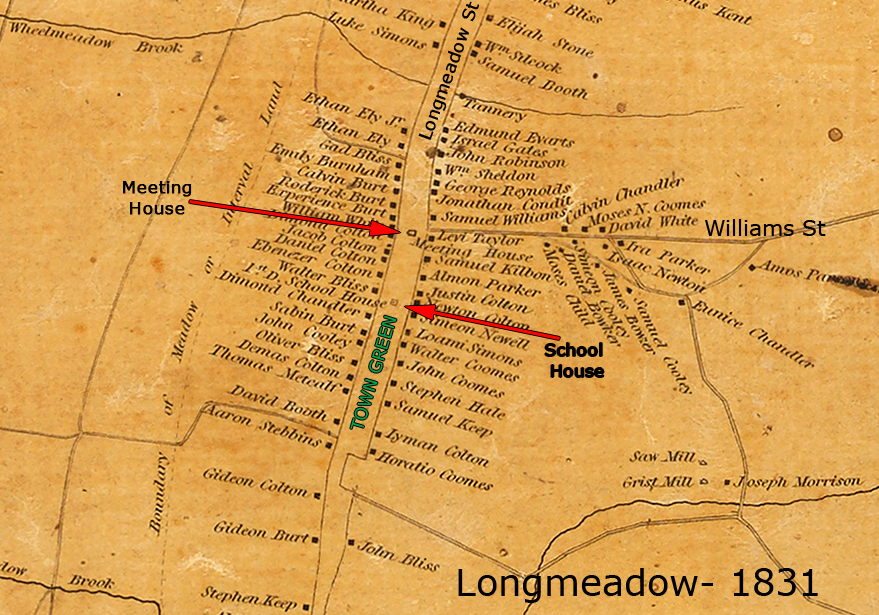
Figure 1- 1831 Map of
Longmeadow Town Green
[click image to enlarge]

Figure 2- 1870 Map of
Longmeadow Town Green
[click image to enlarge]
The Old Country Store
built by Calvin Burt and Stephen Cooley
in 1805 remains today as the
Spa-on-the-Green/ Dr. Glen Brooks as the
only commercial business on the
perimeter of the Town Green.
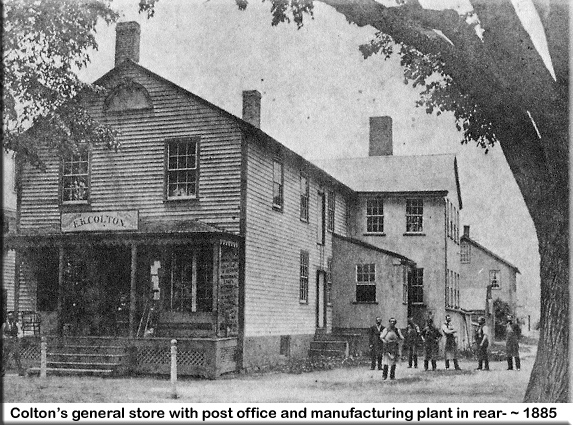
Figure 3- Old Country
Store
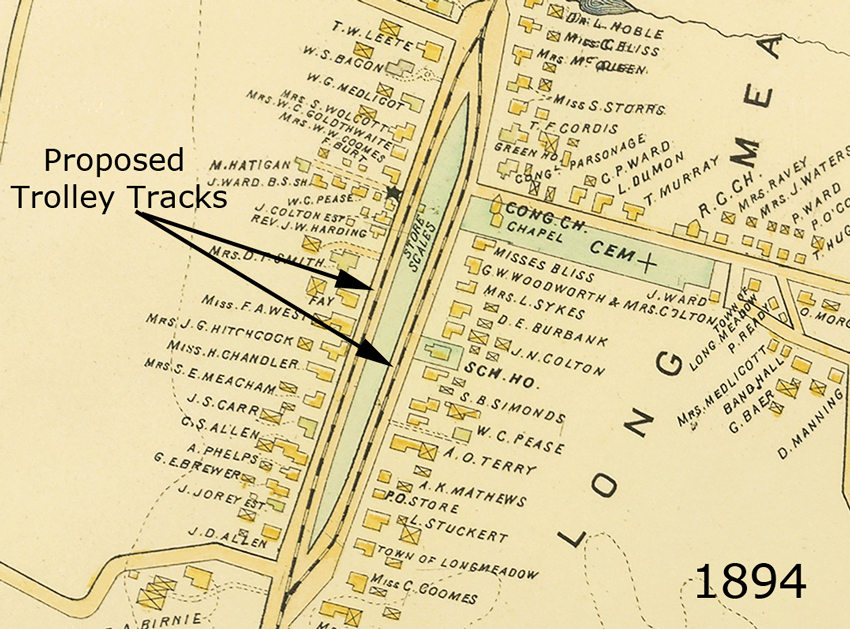
Figure 4- 1894 Map of
Longmeadow Town Green
[click image to enlarge]
After the split of
East and West Villages of Longmeadow on
July 1, 1894, the Springfield Street
Railway launched a commercial enterprise
to provide trolley service from downtown
Springfield to Enfield, CT. The
original layout of the trolley tracks
shown in the 1894 map (see Figure 4)
avoided use of the Town Green but the
final implementation actually utilized a
significant portion of the Town Green
for the tracks and electric power poles/
wires (see Figure 5). Trolley service
was initiated in 1895 and the last
trolley run was in 1940.

Figure 5 - 1894 Map of
Longmeadow Town Green
[click image to enlarge]
Below is an Emerson
photo- (Figure 6) showing the trolley
tracks traversing the Town Green in
1915.
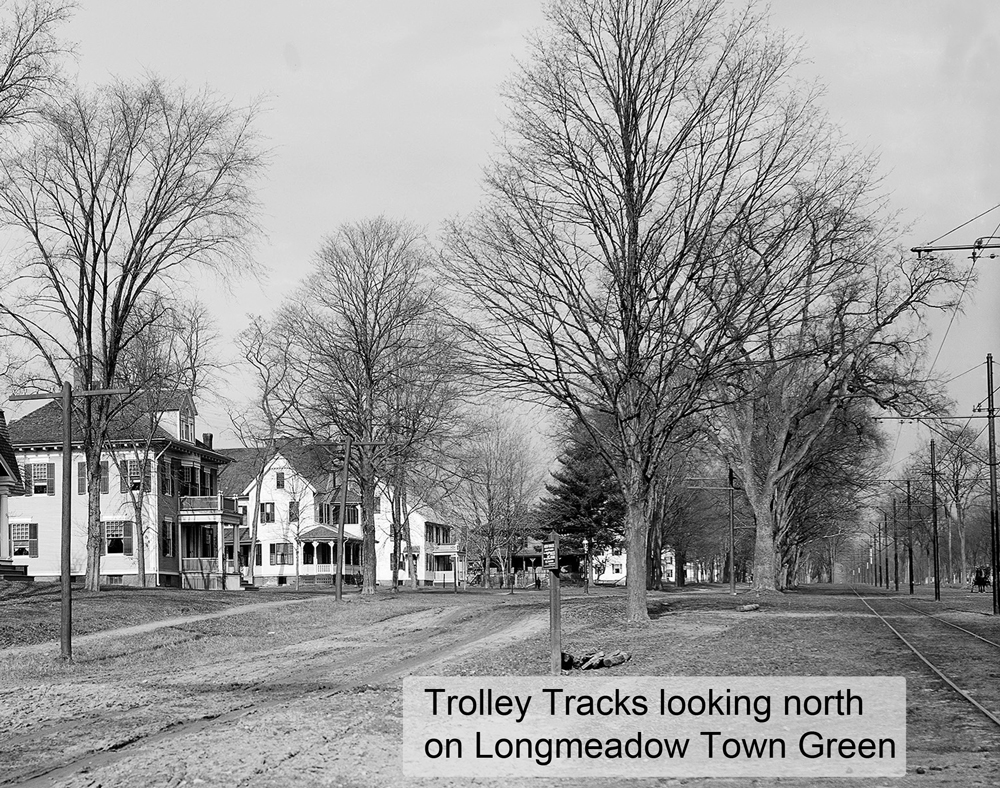
Figure 6 - Springfield
Street Railway- Looking North on Town
Green
|

